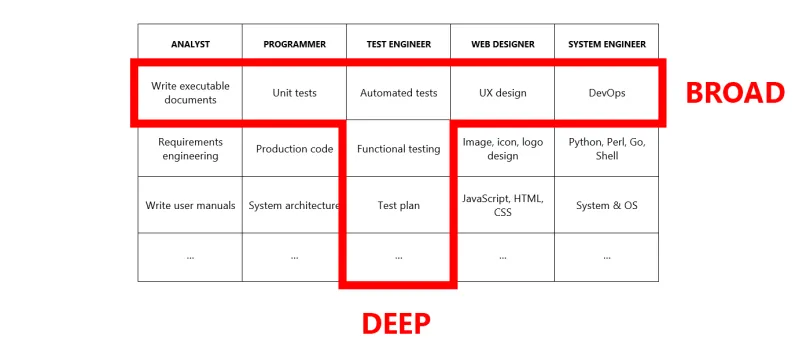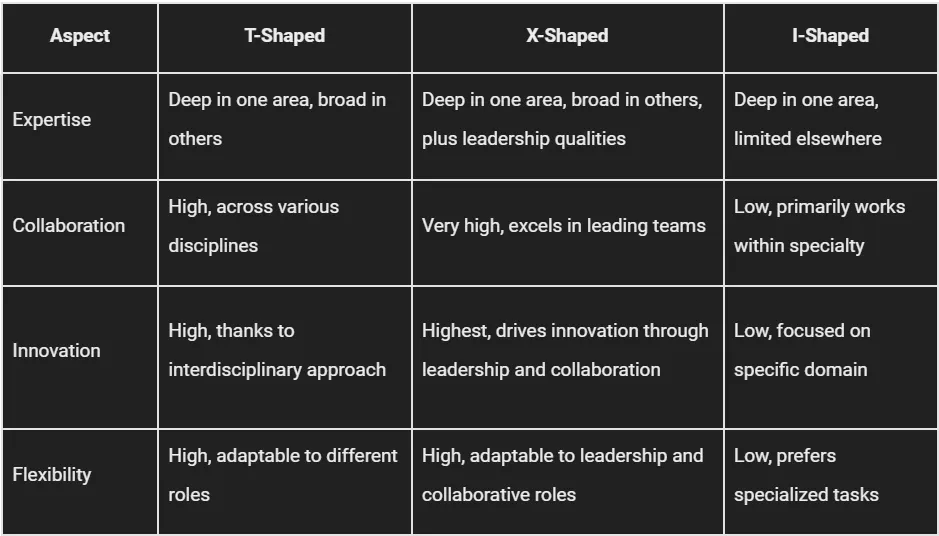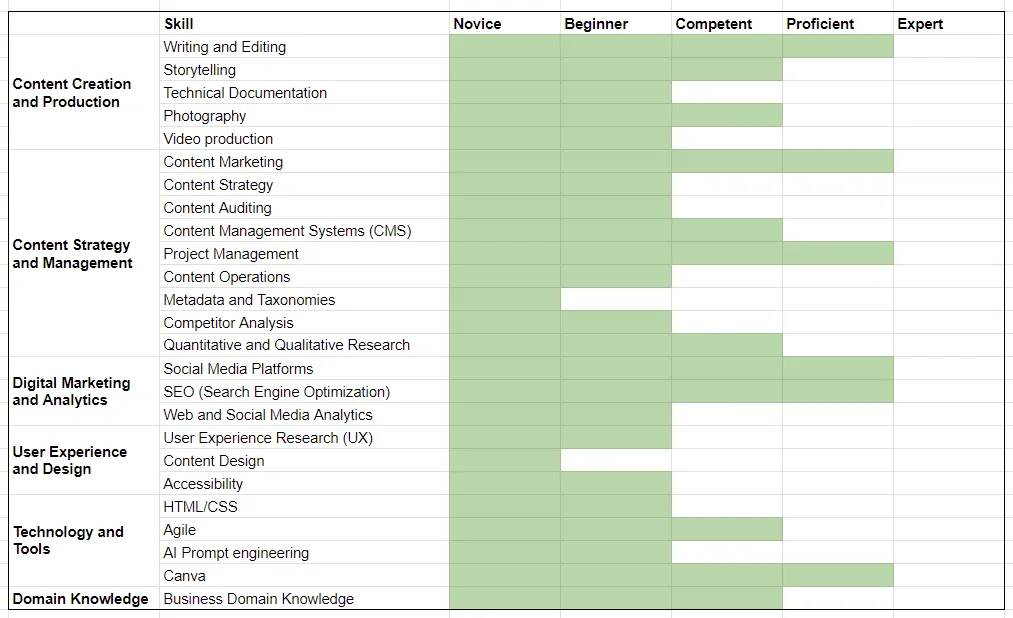What shape is a content strategist?
And no, I’m not talking about hourglass or pear-shaped.
In agile development, we often talk about the T-shaped developer, who is the foundation of a balanced and well-rounded software development team.
A T-shaped developer is a software developer with a deep knowledge of one specific topic and a broad knowledge of various topics. If you could picture this in a graph, it would look something like this:
 Source: https://letslearnabout.net/blog/what-it-is-a-t-shaped-developer-and-why-you-should-be-one/
Source: https://letslearnabout.net/blog/what-it-is-a-t-shaped-developer-and-why-you-should-be-one/
Ideally, each team member would specialize in a different topic, creating a more complete team in skills.
During one of our last attendance weeks, we had a workshop with Jerome Ryckborst where we got hands-on with the Five Sketches model for UX development, and he mentioned the t-shaped person. This got me thinking about myself and my content strategy skills. I’ve been working in content marketing for the past 5 years. I’ve recently taken over a new task at work: to optimize YouTube videos and do keyword research, a skill that I only had broad knowledge about before, but now, it is relatively deep. It made me realize that the time has come to do an inventory of what skills I have gained through my work experience and my current studies.
The “shapes” of people
I asked myself if a content marketer should be T-shaped or if there are other shapes they could take.
I’ve already explained what a T shape means, so let’s go over a few other shapes that I found while doing research for myself:
- I-shaped: This is how you would define a specialist. This person excels in their role but rarely seeks assistance from others. Unlike T-shaped individuals, I-shaped people have a limited breadth of experience and often struggle with cross-team communication.
- X-shaped: These people have t-shaped skills, but they’re paired with leadership. Often, these types of people can lead and inspire them to collaborate.
Abdul Rahman created a simple overview in his LinkedIn blog post:
Further research also led me to Pi-shaped people (similar to T-shaped people but with deep knowledge in two disciplines), V-shaped people (they have great skills in specific functional areas but also have skills in other disciplines), star-shaped people (mapping out skills across 8 points), and tree-shaped people (someone who has a variety of experiences that produce a genuinely well-rounded candidate).
To keep it short, there are plenty of shapes that you could use. But the common denominator between all of those is the skills at the base of them. So, the next step would be to determine what those skills are.
The skills of a content strategist
If you’ve ever had anything to do with content, you know straight away that the types of skills a content strategist could and should learn are very broad. I’ve never met people with such a broad set of skills as many of my study colleagues at FH.
To create an overview, I thought there was no better starting point than the courses we’re taking for the master’s degree in content strategy.
Strategy and Analysis
- Brand values: Principles and standards that guide a company’s actions and decisions, reflecting its identity and beliefs.
- Business strategy: A plan of action to achieve long-term business goals and sustain competitive advantage.
- Digital strategy: A comprehensive plan that leverages digital technologies to improve business performance and customer experience.
- Stakeholder analysis: Identifying and understanding the needs and influence of individuals or groups that affect or are affected by a project or business.
- Quantitative research: Research that involves the collection and analysis of numerical data to identify patterns, correlations, and trends.
- Qualitative research: Research that explores phenomena through non-numerical data like interviews, observations, and textual analysis.
- Data security: Measures and practices to protect data from unauthorized access, corruption, or theft.
- Change management: Planning, implementing, and monitoring organizational changes to achieve desired outcomes.
- Entrepreneurship: Starting and managing a new business venture, including risk-taking and innovation. Content and Communication
- Message architecture: A structured framework for defining and organizing key messages to ensure consistent and effective communication.
- Content auditing: Systematic evaluation of content to assess its quality, relevance, and effectiveness.
- Content management: Creating, storing, organizing, and maintaining content.
- Content management systems (CMS): Software applications that create, manage, and publish digital content.
- Content design: Crafting content that is useful, usable, and accessible, focusing on meeting user needs.
- Content marketing: Creating and distributing valuable content to attract and retain a target audience and drive profitable actions.
- Content ecosystem architecture: Structuring and organizing content across multiple channels and touchpoints to ensure consistency and coherence.
- Topic planning: Identifying and organizing topics and themes for content creation to align with strategy and goals.
- Storytelling: Crafting compelling narratives to engage and connect with the audience.
- Writing: Producing clear, concise, and engaging written content.
- Editing: Revising and improving content for clarity, accuracy, and coherence.
- Curating: Selecting and organizing existing content to present it meaningfully and engagingly.
- Internal communication: Facilitating effective organizational information exchange to support collaboration and productivity.
- Technical documentation: Creating detailed and accurate documents that explain complex technical information and processes.
User Experience and Design
- User experience (UX) research: Studying users and their interactions with products to inform design decisions that enhance usability and satisfaction.
- Interaction design: Designing interactive product elements to ensure a seamless and intuitive user experience.
- User-centered design: Designing products with a strong focus on the end-users’ needs, preferences, and limitations.
- Complex content environments: Managing and designing content systems that involve large volumes of diverse content across multiple platforms.
- Accessibility: Ensuring content and products are usable by people with a wide range of abilities and disabilities.
- Design processes: Structured design approaches, including research, ideation, prototyping, and testing.
Web and Digital Tools
- HTML/CSS: Markup and styling languages used to create and design web pages.
- Web analytics: Tools and techniques for measuring, analyzing, and reporting web data to understand and optimize web usage.
- Social media platforms: Online services that enable users to create and share content or participate in social networking.
- Social media management: Planning, creating, and overseeing social media content and interactions to build and engage an audience.
- Social media analytics: Measuring and analyzing social media data to understand performance and inform strategy.
Management and Operations
- Project management: Planning, organizing, and managing resources to achieve specific project goals and objectives within constraints like time and budget.
- Content operations: Overseeing and optimizing the processes and workflows in creating, managing, and distributing content. Ethics and Legal
- Media law: Legal regulations and standards governing media production, distribution, and consumption.
- Media ethics: Principles and standards guiding ethical behavior and decision-making in media and communication.
- Business domain knowledge: Understanding the specific industry and market in which a business operates to create relevant and effective content.
Analyzing your skill set as a content strategist all at once might be overwhelming and confusing. Would it make more sense to break it down by different content roles? For example:
Content Designer
- User Experience Research (UX)
- Content Auditing
- Content Design
- Content Management Systems (CMS)
- Accessibility
- HTML/CSS
- Interaction Design
- User-Centred Design
- Content Ecosystem Architecture
- Business Domain Knowledge
Content Marketer
- Content Marketing
- Social Media Platforms
- Content Strategy
- SEO (Search Engine Optimization)
- Writing and Editing
- Content Analytics
- Storytelling
- Content Auditing
- Business Domain Knowledge
Content Manager
- Content Management Systems (CMS)
- Project Management
- Content Strategy
- Content Operations
- Stakeholder Analysis
- Quantitative and Qualitative Research
- Internal Communication
- Content Auditing
- Business Domain Knowledge
- Technical Documentation
Content Editor
- Writing and Editing
- Curating
- Content Auditing
- Metadata and Taxonomies
- Content Management Systems (CMS)
- Storytelling
- Media Ethics
- HTML/CSS
- Technical Documentation
Content Operator
- Content Management Systems (CMS)
- Content Operations
- Content Auditing
- Project Management
- Digital Tools
- Internal Communication
- Data Security
- Change Management
- Technical Documentation
- Business Domain Knowledge
This seems a bit better, and I might add or remove some skills based on personal experience.
Now that we have an overview of the skillset, we might want to consider how to define knowledge depth.
The Dreyfus model
A model that’s widely used to assess somebody’s proficiency with a specific skill set is the Dreyfus model. This can be categorized into several levels:
- Novice: Basic understanding, needs guidance.
- Beginner: Some practical experience, limited supervision.
- Competent: Good grasp, handles most tasks independently.
- Proficient: Deep knowledge, extensive experience, mentors others.
- Expert: Recognized authority, innovates, and provides thought leadership.
Assessing Depth of Knowledge
To assess someone’s depth of knowledge in a specific skill, consider:
- Experience: Duration and variety of experience in applying the skill.
- Education: Formal training, courses, certifications, and continuous learning efforts.
- Performance: Quality and complexity of tasks they can handle independently.
- Problem-Solving: Ability to troubleshoot and resolve issues, especially novel or complex ones.
- Mentoring: Capability to teach, guide, and mentor others in the skill.
- Innovation: Contribution to developing new methods, practices, or thought leadership.
Individuals can more accurately gauge skill levels and identify areas for further development.
Putting it all together
So now it’s time to get down to business. I’m currently working in a role that’s a mix of content management, marketing, editing, and community management. However, I also gained experience in technical writing and agile project management in my previous roles.
I decided to make a graph and select the skills that you can find under “content manager”, “content editor,” and “content marketer”. I also added a few more skills that I gained from my work experience and my studies in Content Strategy, including 25 skills. Don’t ask me why 25; it’s an arbitrary number that felt right.
So here it is:
What have I learned from this? It’s hard to define yourself as a T-shaped person in a domain that’s so multi-faceted. Among the 6 categories, none trumps the others for depth of knowledge (maybe just Digital Marketing and Analytics, since ⅔ have proficient knowledge, but it’s also one of the categories with the least skills). If you would arrange the skills accordingly, it might be more akin to a V-shaped person with a very flat point.
Furthermore, it’s very hard to call yourself an expert in something. I think it’s impossible to know everything there is to know about a specific topic, especially because the field of content strategy is constantly evolving.
This topic may require further research, but at this point, I can just say that I realized the importance of regularly assessing the status of your skills. It gives you an idea of where you’re in your development journey and where you might want to invest more time to deepen your knowledge.
And as for the question of which shape a content strategist comes or should come in, it remains to be answered. Or rather, there might not even be a real answer: it depends.
For now, I’ll leave my reflections to this!


